The Good, the Bad, and the Ugly: UNFPA’s Nairobi ICPD+25 Summit – Part 2
Note: This second part of our special report will provide extensive, never-before revealed evidence of the UN’s radical anti-family and anti-life agendas. Please take the time to sign the Life and Family Nairobi Declaration here. Thank you!
Special Report
by Sharon Slater, President of Family Watch International
Part II
For Part I, which provides the background on the Nairobi Summit and the many good and positive outcomes from the Summit, please click here.
The Bad
1. UNFPA Openly Discriminates Against Pro-Life, Pro-Family and Religious Persons. As briefly mentioned in Part I of this special report, the Nairobi Summit was the first time UNFPA effectively blocked pro-life, UN-accredited NGOs from even participating in their radical UN-sponsored conference held November 12-14, 2019. Pro-family NGOs often have been at a disadvantage at the UN due to unfair procedures, but we always have worked through such problems to advocate our positions and have never been completely shut out of the UN process that creates international policies.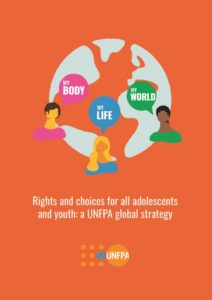
2. UNFPA’s Deceptive Goals. Many governments and NGOs committed to UNFPA’s suggested sexual and reproductive health and rights (SRHR) goals thinking they were about preventing maternal mortality, gender violence, promoting gender equality and empowering women and girls. However, as will be shown in the “Ugly” sections below, the Nairobi Summit organizers intended all along to define SRHR in a way that would include and advance controversial abortion, LGBT, comprehensive sexuality education (CSE) rights, and more as the solution for maternal mortality and the empowerment of women and girls. UNFPA and its partners moved their agenda forward in Nairobi by employing many nice-sounding terms that were never a part of any of the official ICPD conference documents—terms like “sexual minorities,” “marginalized youth,” “rights and choices for youth,” and “bodily autonomy.” Multiple calls were made to end “unsafe abortion” by legalizing abortion as if that somehow would make abortions “safe.” One of their favorite talking points was to always associate “sexual minorities” with indigenous and disabled persons to create LGBT status as a victim class needing special protection. This was a play right out of the LGBT handbook, “After the Ball.” 
The Ugly – UNFPA’s Initiatives to Sexualize our Children
- UNFPA’s Dangerous “Safeguard Youth” Program is Exposed. While doing research on UNFPA’s youth strategy for the Nairobi Summit, Family Watch learned that UNFPA had already launched a phone app that openly promotes promiscuity, abortion, homosexuality and transgenderism to youth. UNFPA refers to it as a comprehensive sexual and reproductive health (SRH) education phone app named “Tune Me.” This digital CSE app has already reached over four million African youth in seven countries. Consider the following CSE teachings that appear in the Tune Me app that most African parents have no idea exists on many of their kids’ cell phones and would be outraged if they did:
Direct Quotes from UNFPA’s Tune Me Phone App for Youth:
- Masturbation: “One way to have an orgasm is through masturbation or touching yourself in a way that feels pleasurable. It’s safe and normal to masturbate … If you learn first how to have an orgasm by yourself, it may be easier for you to have one when you have sex with someone else.”

From UNFPA’s “Tune Me” Mobile App
- Anal Sex: “Anal sex is when a man inserts his penis into someone’s bum (or back passage). Anal sex is a topic people don’t often want to talk about. Anal sex is also illegal in Zambia so that makes it doubly taboo. But that doesn’t mean it doesn’t happen!”
- Oral Sex: “Oral sex is when one partner uses their mouth, lips or tongue on their genitals to pleasure their partner … Use flavoured condoms if you have them … Not sure about a girl’s bits or what gets her excited during sex? Find out more.”
- “Ending a Pregnancy—How Does a Termination Work? … In a surgical termination, a doctor performs an operation in a clinic to remove the contents of the uterus … It is offered under certain conditions at government health facilities, PPAZ [Planned Parenthood Association of Zambia] or Marie Stopes/Blue Star clinics. Call the Marie Stopes helpline for emergency advice on 5600.”
- “‘Sex is the best’ But the guys lied to me … It was as good as all the boys had told me. It was the best moment.”
- “Think You Could be Gay? … It is not uncommon for young people to explore their sexuality with someone of the same sex. In many countries gay men and women live and love openly, and even get married.”
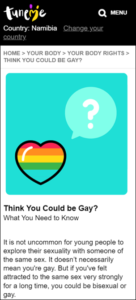
From UNFPA’s “Tune Me” Mobile App
- “How Girls Orgasm … An orgasm is a feeling of intense pleasure from sexual stimulation. It is a series of very pleasurable, rapid contractions of the vagina, uterus and anus.”
- UNFPA Launched a Radical “New Global Youth Strategy” in Conjunction With the Nairobi Summit. This youth initiative, called “My Body, My Rights, My World—Rights and choices for all adolescents and youth: a UNFPA global strategy,” is highly controversial. Consider the following very troublesome elements of the strategy (we included page numbers so you can look up the unbelievable references at the link above):
- UNFPA’s Vision (page 8): “A world where every young person can make their choices and enjoy their rights.”CONCERN: This sounds so nice. However, parents everywhere should be asking UNFPA which choices and which rights for young people are included and at what age. UNFPA’s materials go on to pit highly controversial adolescent sexual “rights” against the well-established rights of parents (see below). According to UNFPA, body rights include unfettered “access to integrated sexual and reproductive health services and information for all adolescents and youth.” What does this mean? According to the UN Secretary-General, it includes, in part, the advancement of the “rights and participation of young people in all their diversity.” The phrase “in all their diversity” is highly controversial in UN negotiations and is always rejected because it is used as a euphemism for LGBT youth. Read on to learn what else it means.
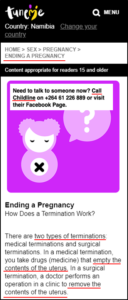
From UNFPA’s “Tune Me” Mobile App
- UNFPA (Page 7): A “Rights Imperative” for adolescents is defined to encompass a right for children to make choices that “occur early in life,” including “affirming sexual orientation and gender identity” and “deciding when and with whom to have sex.”
CONCERN: Since when did children (or adolescents, as UNFPA calls them, which begin at 10 years old according to the agency) get rights to make their own sexual decisions? UNFPA is outright promoting rights for children to (i) have sex with whomever they want whenever they want, and (ii) be affirmed in whatever gender identity they choose. What about the children’s parents? What authority does UNFPA have to try to grant these radical rights to children to which neither their parents nor Member States have consented? Do UNFPA’s fictitious rights also include transgender hormones and surgeries for youth without parental consent? UNFPA needs to be reined in.
- UNFPA (Page 17): “We act to prevent … unsafe abortion and its consequences.”
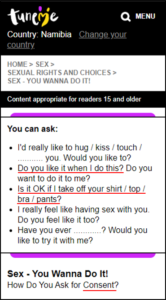
From UNFPA’s “Tune Me” Mobile App
CONCERN: What UNFPA means is that the UN agency wants to end “unsafe abortion” by promoting its legalization across the world. UNFPA and its abortion-minded partners equate “unsafe abortion” with illegal abortion, and they argue that legalizing abortion will prevent maternal death and other consequences. But their real agenda is to promote abortion globally by legalizing it everywhere as UNFPA’s best friends and major partners in organizing the Nairobi Summit included Marie Stopes and IPPF, the largest providers of abortion in the world, among many others. UNFPA’s messaging is a very deceptive play on words and ignores the real and significant consequences of abortions, whether performed legally or illegally, as documented in Family Watch’s brief on the negative consequences of abortion.
- UNFPA (Page 17): “We support … a health workforce able to deliver high-quality, non-judgmental and confidential services to adolescents and youth.”
CONCERN: When UNFPA says “confidential services” they mean services given to youth that are kept confidential from the parents—that is, without their knowledge and consent. See, for example, the World Health Organization’s publication, “Making Health Services Adolescent Friendly,” which defines “confidential” on page 34 as “staff do not disclose any information given to or received from an adolescent, to a third party (for example, family members…) without their consent.” UNFPA and their pro-abortion partners also define a “non-judgmental” health workforce to mean workers who are LGBT supportive and that condone, or at least do not oppose, promiscuity and abortion.
- UNFPA (Page 20): Our “approach is access to comprehensive sexuality education (CSE)” and “safe schools and spaces for adolescents.”
CONCERN: We already saw the kind of CSE that UNFPA intends to indoctrinate youth with based on the contents of UNFPA’s Tune Me phone app (see above). CSE is UNFPA’s number one tool for advancing its radical agenda to indoctrinate and sexualize children. With regard to “safe schools and spaces,” see the U.S. publication “Creating Safe Spaces for LGBT Youth,” which describes “safe spaces” as “places where LGBT youth can feel free to express their sexual orientation, their gender identity, their gender expression, as well as all of the other dimensions of their being without fear.” UNFPA says such spaces are “critical to proper development.” With regard to “safe schools,” Keven Jennings, founder of the Gay, Lesbian and Straight Education Network (GLSEN) that is the leading U.S. education organization focused on promoting homosexuality in schools, was appointed to be the U.S. “safe schools” czar. That is, until he was pressured to resign for using this banner to promote homosexuality in U.S. schools. In other words, “safe schools” and “safe spaces” are terms often used as euphemisms for LGBT-affirming and LGBT-supportive spaces.
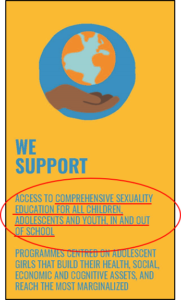
From UNFPA’s My Body, My Life, My World
- UNFPA (page 20): “We emphasize respect for adolescents’ agency and autonomy, partnering with them rather than serving them as passive beneficiaries.”
CONCERN: Every parent should be very concerned that a UN agency is trying to partner with their adolescent child to help them embrace “autonomy” in sexual matters. This initiative is right out of IPPF’s sexual rights handbook.
- UNFPA (Pages 21, 28): We act to increase “access to sexual and reproductive health and rights, and address inequalities so adolescents and youth can make informed choices about their bodies … We act to end …”
–“stigma based on age, gender, sexual orientation,”
CONCERN: How will UNFPA end such stigma? By promoting LGBT rights for youth.
–“early and/or unintended pregnancies”
CONCERN: How will UNPFA end such pregnancies? By securing abortion.
–“discriminatory power structures and gender and social norms”
CONCERN: How will UNFPA end such alleged discriminatory norms? Changing moral laws and religious norms by indoctrinating the rising generation and going around parents to create and advance rights for youth to abortion, LGBT privileges, and promiscuity.
In summary, with UNFPA’s global strategy “My Body, My Rights, My World—Rights and choices for all adolescents and youth,” UNFPA and their partner NGOs and governments have finally come out of the closet with their truly radical and harmful agenda for youth. This strategy is not based in and has nothing to do with international law and everything to do with a radical sexual agenda concocted with NGOs like IPPF who benefit monetarily from the negative consequences of early and promiscuous sex.
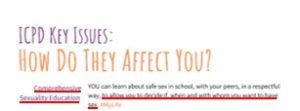
From the UNFPA Youth Engagement Toolkit
3. UNFPA Releases Radical ICPD25 Youth Engagement Toolkit. Just when we thought it couldn’t get any worse, UNFPA exposes its harmful agenda even further with its “ICPD25 Youth Engagement Toolkit.” In their youth toolkit, UNFPA outlined the following as “ICPD Key Issues” for adolescents even though none of these concepts were ever part of ICPD, and many UN Member States would strongly oppose them:
- The SRHR Abortion Agenda in UNFPA’s Own Words (Pages 5, 6, 8 and 13): “A comprehensive SRHR approach includes safe abortion care … without these services, we will never be able to end preventable maternal mortality.” It continues: “Making informed choices over your body means having access to SRH services and information and being able to exercise your SRHR, regardless of age … Comprehensive SRHR include[s] … safe abortion care…” (pages 5 and 6). “Access to Safe Abortion Care: “YOU have safe options other than pregnancy. #MyBody” (page 8). “Young women particularly face challenges in accessing … abortion care,” including “requirements regarding age” and “parental … consent requirements and restrictions” (page 13).
- “Comprehensive Sexuality Education” (Pages 6 and 8): According to UNPFA, “Access to CSE is a human right; an individual [translation: adolescents] should be able to make informed decisions … about their own sexuality and reproduction … YOU can learn about safe sex in school … to allow you to decide if, when and with whom you want to have sex. #Mylife.”
CONCERN: These UNFPA quotes provide yet another proof point that CSE is all about promoting promiscuity to youth through schools under the deceptive euphemism of “safe sex,” which ignores all of the physical, psychological and other harms resulting from sex outside of marriage. Family Watch will not express concerns where they are obvious, unless (as in this case) we feel a need to repeatedly ring an alarm.
- “LGBTI and Human Sexuality” (Page 8): “YOU alone should have the right to decide what your body and sex characteristics look like, to express your authentic, (non-) gendered self, and to love who you wish to love. #MyLife”
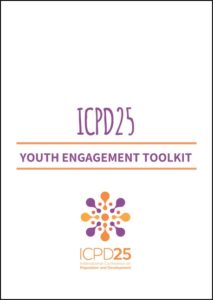
CONCERN: This assertion may be the most concerning of all. UNFPA is actually saying that adolescents have the right to decide to use puberty blockers, dangerous cross-sex hormones, and genital mutilating and breast-removing surgeries without parental interference, so they can determine how their body should look (even if it does not correspond to their biological gender). Surely UNFPA has gone too far, putting this in a training kit for the world’s youth! The American College of Pediatricians has determined that transgenderism in children amounts to child abuse. See their statement here.
- “SRHR and CLIMATE CHANGE” (Page 7): “…young people have been vocally pushing for more climate ambition … However, more needs to be done to link SRHR with climate change.”
CONCERN: UNFPA’s attempt to link SRHR and climate change shows how desperate they are to implement their sexual agenda among the youth and that they will link SRHR to any vehicle they can to get it implemented.
The Ugliest of the Ugly
There are at least 10 very serious problems with the Nairobi Summit Outcome Statement and its Commitments. ICPD Outcome Statements are not international treaties, but some governments have treated them as legally binding because they typically contain consensus language. The good news is that ten countries clearly rejected those commitments (see Part I of this report), and because of those dissensions and other strong opposition, the Nairobi Statement clearly states that it is non-binding and does not infringe in any way on the national sovereignty of the countries that support it. But let no one be fooled: UNFPA and its partners will refer to the Nairobi Summit Outcome Statement in future UN conferences as an indication of allegedly growing global support for UNFPA’s radical sexual agenda. (See Action Items at end of this report on how to counter the Nairobi Statement.)
Here are the Ten Serious Problems:
1. Claims to represent “all nations and peoples, and all segments of our societies”; defines the empowerment of girls as “ensuring [their] sexual and reproductive health and rights” and calls for “active protection of sexual and reproductive health and rights (SRHR) and human rights defenders.”
CONCERN: UNFPA is recruiting yet more partners, and even youth, to be “defenders” of its SRHR agenda. UNFPA and its partners are attempting to make it look like their SRHR agenda has worldwide support and thus it is an international custom or norm that governments must respect and adopt.
2. Calls for “universal access to sexual and reproductive health and rights as a part of universal health coverage (UHC) … integrating a comprehensive package of sexual and reproductive health interventions” guided by “the expanded definition of SRHR interventions, as proposed in the Report of the Guttmacher/Lancet Commission on sexual and reproductive health and rights.”
CONCERN: The Guttmacher/Lancet commission referenced in the Nairobi Statement lists “abortion services” and “comprehensive sexuality education” as components of an essential SRHR package.
3. Calls upon governments to provide “access to safe abortion to the full extent of the law” and to “uphold the right to sexual and reproductive health services in humanitarian and fragile contexts, by … the provision of access to comprehensive sexual and reproductive health information, education and services, including access to safe abortion services to the full extent of the law.”
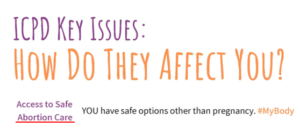
From the UNFPA Youth Engagement Toolkit
CONCERN: As the language above shows, any time UNFPA is addressing SRH or SRHR services, it’s all about CSE and abortion. There are two problems with this commitment:
- The UNFPA language, “provision of access to comprehensive sexual and reproductive health information, education and services,” is one of many derivations of comprehensive sexuality education or CSE. See #8 below for the major problems with CSE and how such programs sexualize our youth.
- UNFPA’s most deceptive abortion advocacy terms are “unsafe abortion” and “safe abortion.” UNFPA expects us to believe that abortion somehow magically becomes “safe” when abortion laws are liberalized or when it is otherwise labeled as “safe” (i.e., UNFPA’s constant use of the term “safe abortion”). UNFPA also expects us to believe abortion is always unsafe when it is illegal. These lies are often effective because no one wants anything that is labeled “unsafe” to continue, so governments are tempted to legalize abortion to allegedly make it safer. However, there is no such thing as a “safe” abortion! Each and every abortion is “unsafe” for the child it kills, and every abortion, regardless of whether it is legal and/or performed under the best medical conditions, carries inherent physical and mental health risks for the mother. (See Family Watch’s policy brief on the negative consequences of abortion.)
4. Build “peaceful, just and inclusive societies, where no one is left behind, where all, irrespective of race, colour, religion, sex, age, disability, language, ethnic origin, sexual orientation and gender identity or expression, feel valued and are able to shape their own destiny and contribute to the prosperity of their societies.”
CONCERN: This sounds so beautiful, doesn’t it? But establishing sexual orientation and gender identity as protected classes equal to race, colour, disability and religion actually is harmful to the very people it seeks to elevate. Governments should not (i) encourage people (especially youth) to identify themselves based on their sexual preferences and/or gender confusion; or (ii) grant special rights to such individuals, especially when acting out on these preferences or confusions that may be temporary can lead to more negative outcomes for them.

UNESCO’s “Out in the Open”
The controversial nature of the Nairobi Outcome Statement continues as it commits governments to the following with regard to children:
5. Provide quality, timely and disaggregated data … inclusive of younger adolescents,” which UNFPA defines as “10-14 years of age.”
CONCERN: Perhaps UNFPA wants to track data on 10-year-old children so it can use the data to determine how to apply its radical SRHR agenda to adolescents as young as 10.
6. Invest in “digital health innovations.”
CONCERN: For example, UNFPA’s explicit “Tune Me” sex education app is a “digital health innovation” that sexualizes youth.
7. Adhere to the notion that “no decision on the health of youth can be made without their “meaningful involvement” (i.e., “nothing about us, without us”).
CONCERN: While this concept sounds reasonable, remember UNFPA’s push for governments to provide sexual services such as abortion to youth without parental consent. Also, UNFPA’s advocacy for the right of youth to participate in policymaking about anything that concerns them, is really just a ruse to give the 6,000 youth they have trained in their radical SRHR agenda the power to push it in legislatures and policymaking bodies around the world.
8. Obligates governments to provide CSE: Governments must provide “access for all adolescents and youth, especially girls, to comprehensive and age-responsive information, education and adolescent-friendly comprehensive, quality and timely services.” Then it adds a footnote that the education should be “in line with international technical guidance.”
CONCERN: The type of sexual education referred to is found in the UN’s International Technical Guidance on Sexuality Education (2018), which redefines abstinence to include “deciding when to start having sex and with whom” (page 71), and claims that abstinence programs “have been found to be ineffective and potentially harmful to young people’s sexual and reproductive health and rights” (page 18). The UN technical guidance also holds that sexuality [and thus sexuality education] encompasses “gender identity; sexual orientation; sexual intimacy; pleasure…” (page17); promotes “diversity in the way young people manage their sexual expression” (page 18); says adolescent girls are “generally less knowledgeable about their rights concerning abortion” (page 23); and asks students to “question social and cultural norms that impact sexual behaviour” (page 48), and to “differentiate between values they hold, and that their parents/guardians hold about sexuality” (page 46).
9. Enable adolescents and youth “to be able to make free and informed decisions and choices about their sexuality and reproductive lives.”
CONCERN: Adolescents (starting at age 10 as defined by UNFPA) do not have fully developed brains, nor do they have a right to make decisions and choices without the guidance of their parents who can protect them against harmful sexual agendas like the one UNFPA is openly promoting.
10. Invest in “sexual and reproductive health services, of adolescents and youth, especially girls,” so as to fully harness the promises of the demographic dividend.
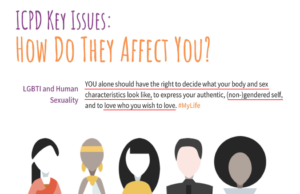
From the UNFPA Youth Engagement Toolkit
CONCERN: The “demographic dividend” is a deceptive device used by UNFPA to entice developing countries into advancing UNFPA’s SRHR agenda as a way to reap economic benefits by suppressing the growth of their populations.
And all of this is what governments committed to if they signed the Nairobi Summit Outcome Statement! Although the Nairobi Statement is non-binding, at the Summit UNFPA received financial commitments of $9 billion ($1 billion from governments and $8 billion from private donors). These funds will be used to advance UNFPA’s harmful SRHR agenda in future UN conferences and other policymaking venues, which should concern us all. (See UNFPA Closing Ceremony.)
So What Can You Do About All This?
- Pass this report on to as many people as you can! Knowledge is power, and this report provides clear evidence never before seen of UNFPA and its partners’ desire to sexualize our children. Make sure you send them both Part 1 and Part II of the report.
- Read the U.S.-led statement joined by ten countries against the ICPD+25 outcome document.
- Ask your government to withhold all future funding for UNFPA unless it is targeted for specific humanitarian aid that has no SRHR components. For example, the Trump administration has withdrawn funding for three years in a row. To ensure your government is not funding UNFPA’s SRHR agenda, highlight some of the evidence of that agenda from this report and send it to relevant officials (e.g., your government’s UN diplomats and ministers that deal with foreign affairs, health, gender, youth or education).
- Investigate whether UNFPA’s Tune Me phone app has been distributed to youth in your country, and request that your legislators ban it as soon as possible and/or prevent its future use.
- Ask your government to investigate and stop any sex/sexual/sexuality education programs, especially comprehensive sexuality education programs that are driven by UNFPA and/or any of its partners (like IPPF, IPAS, Rutgers, Women Deliver, etc.) and being taught in your community through school programs or phone apps (see the “CSE materials exposed” page at org for a list of different CSE programs pushed by UN agencies).
- Sign the Pro-Life and Pro-family Nairobi Summit Declaration that is the alternative document to the UNFPA led Nairobi Statement. (learn more about the Declaration in Part I of this report.) The more people that that sign the alternative declaration, the less credibility UNFPA’s Statement will have in the future.
- Sign up for the Family Watch Newswire so you can be kept informed on the UN-driven SRHR agenda and related issues.

